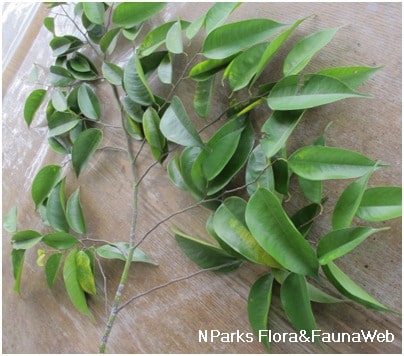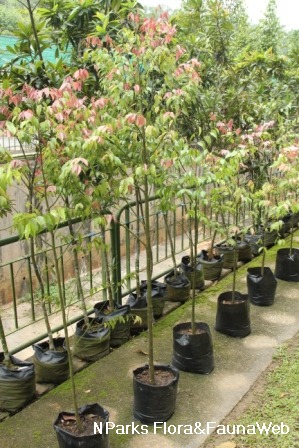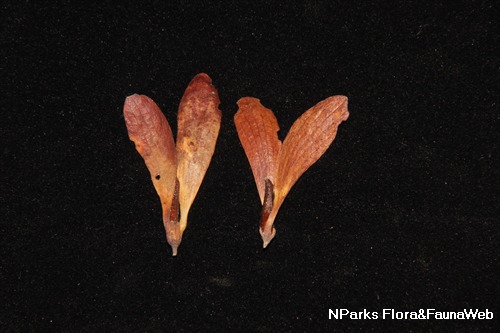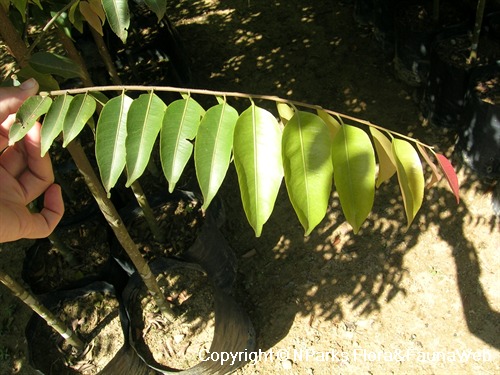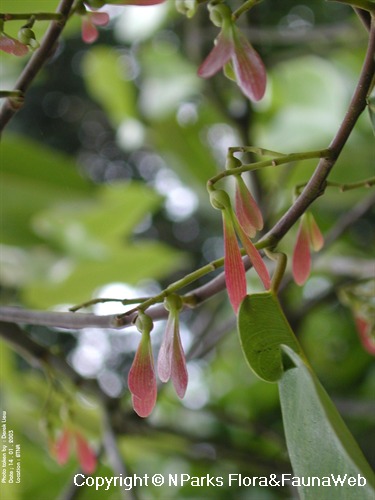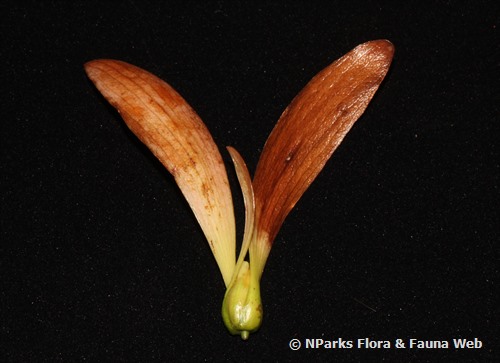
Back
Hopea griffithii Kurz
| Family Name: | Dipterocarpaceae |
| Common Name: | Merawan Jantan, Perawan, Pengerawan Bunga |
Name
Classifications and Characteristics
| Plant Division | Angiosperms (Flowering Seed Plants) (Dicotyledon) |
|---|---|
| Plant Growth Form | Tree (Big (>30m)) |
| Lifespan (in Singapore) | Perennial |
| Mode of Nutrition | Autotrophic |
| Plant Shape | Irregular |
| Tree or Palm – Trunk Diameter | 2 |
Biogeography
| Native Distribution | Peninsular Myanmar, Tarutao Island (Thailand), Peninsular Malaysia, Singapore, Borneo. |
|---|---|
| Native Habitat | Terrestrial (Primary Rainforest) |
| Preferred Climate Zone | Tropical |
| Local Conservation Status | Native to Singapore (Endangered (EN)) |
| CITES Protection | True |
Description and Ethnobotany
| Growth Form | It is a tree up to 40 m tall. |
|---|---|
| Trunk | The bark is smooth, dark coloured with lighter patches, becoming rough and fissured when old. The bark sheds in small oblong shaped scales. |
| Roots | Its buttress roots are sharp, tall and stilted. |
| Foliage | Its alternate, stalked leaves have leathery leaf blades that are ovate to elliptic-lanceolate, with a long pointed tip, 4-9 cm by 1.7-3 cm, and purplish brown above and yellowish brown below when dry. The midrib is depressed on top. |
| Flowers | Its dark red flowers have five lanceolate petals. Flowers are borne on terminal or axillary branched panicles that are up to 2.5 cm long. |
| Fruit | Its fruits consist of an ovoid nut that is 0.7 by 0.5 cm, with 2 longer wings that are about 3 by 0.5 cm, and 3 shorter wings that are about 0.8 by 0.1 cm. |
| Habitat | It grows in forests on leached, yellow clayey soil up to 500 m altitude. It occurs locally in Bukit Timah Nature Reserve. |
| Associated Fauna | It has insect-pollinated flowers. |
| Cultivation | It can be propagated by seed. |
| Etymology | Latin Hopea, commemorating John Hope (1725-1768), the first Regius Keeper of the Royal Botanic Garden, Edinburgh; Latin griffithii, commemorating William Griffith (1810-1845), a surgeon in the British East India Company at Malacca, Peninsular Malaysia |
| Ethnobotanical Uses | Timber & Products: The tree is harvested for timber. |
Landscaping Features
| Landscaping | It may be suitable for parks. |
|---|---|
| Desirable Plant Features | Ornamental Flowers, Ornamental Fruits |
| Landscape Uses | General, Parks & Gardens, Shade Providing Tree / Palm, Focal Plant, Reforestation |
Fauna, Pollination and Dispersal
| Pollination Method(s) | Biotic (Fauna) |
|---|---|
| Seed or Spore Dispersal | Abiotic |
Plant Care and Propagation
| Light Preference | Full Sun, Semi-Shade |
|---|---|
| Water Preference | Moderate Water |
| Plant Growth Rate | Slow |
| Rootzone Tolerance | Moist Soils, Well-Drained Soils, Fertile Loamy Soils, Heavy Clay Soils |
| Propagation Method | Seed |
Foliar
| Foliage Retention | Evergreen |
|---|---|
| Mature Foliage Colour(s) | Green |
| Mature Foliage Texture(s) | Leathery |
| Foliar Type | Simple / Unifoliate |
| Foliar Arrangement Along Stem | Alternate |
| Foliar Attachment to Stem | Petiolate |
| Foliar Shape(s) | Non-Palm Foliage (Ovate, Lanceolate, Elliptical) |
| Foliar Venation | Pinnate / Net |
| Foliar Margin | Entire |
| Foliar Apex - Tip | Acuminate, Caudate |
Non - Foliar and Storage
| Trunk Type (Non Palm) | Woody |
|---|---|
| Mature Bark Texture | Smooth, Fissured |
| Root Type | Underground |
Floral (Angiosperm)
| Flower & Plant Sexuality | Bisexual Flowers |
| Flower Colour(s) | Red |
|---|---|
| Flower Grouping | Cluster / Inflorescence |
| Flower Location | Axillary, Terminal |
| Flower Symmetry | Radial |
| Inflorescence Type | Panicle |
| Flowering Period | Every Few Years |
| Flower Colour(s) Remarks | Dark red |
Fruit, Seed and Spore
| Mature Fruit Colour(s) | Brown |
|---|---|
| Fruit Classification | Simple Fruit |
| Fruit Type | Indehiscent Dry Fruit , Nut / Nutlet |
Image Repository
Others
| Master ID | 31268 |
|---|---|
| Species ID | 5663 |
| Flora Disclaimer | The information in this website has been compiled from reliable sources, such as reference works on medicinal plants. It is not a substitute for medical advice or treatment and NParks does not purport to provide any medical advice. Readers should always consult his/her physician before using or consuming a plant for medicinal purposes. |

